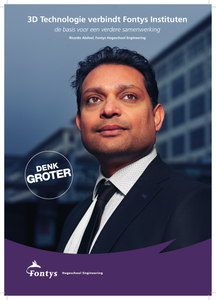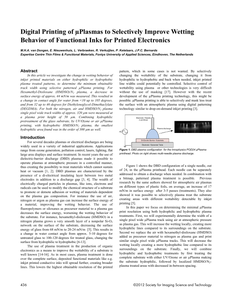This is the first draft of the large scale 3d printing protocol for granulated thermoplastics. The main purpose of this document is to share the key steps of operating, preparation, data entry, and optimization procedures while handling the robotic 3d printing equipment. One main aspect of this protocol is that it is independent of specific 3d printing hardware or software setups. The aim is to have the users from robotic 3d printing from various technologies follow these steps and be able to set the basics up when it comes to handling such 3d printers.
DOCUMENT

De wereld verandert in een razend tempo. Technologische ontwikkelingen hebben een grote impact op mens en maatschappij. Het verandert niet alleen onze manier van werken maar ook onze manier van leven. Steeds meer disciplines hanteren technologie als basis om in een professionele omgeving het werk kwalitatief beter, sneller en effi ciënter uit te voeren. Digitalisering, globalisering en informatisering maakt het mogelijk om plaats- en tijdonafhankelijk te studeren en te werken. Fontys Hogescholen speelt hier op in door tal van initiatieven te ondersteunen die gericht zijn op het volgen van deze en opkomende trends rondom technologische ontwikkelingen en de impact voor het onderwijs. Met het Fontys Objexlab zetten we deze beweging door. Opkomende technologieën zoals 3D printing en Robotica maken we graag toegankelijk voor collega’s. Andere instituten kunnen hiervan gebruik maken zodat zij hun onderwijs nog aantrekkelijker en actueler kunnen maken. In het najaar van 2014 zijn we gestart met het samenbrengen van collega’s van verschillende instituten en opleidingen om enerzijds deze nieuwe technologieen te leren en te ervaren, om daarna een stap te maken in het initiëren van ideeën en plannen om met deze kennis en vaardigheden onderwijsvernieuwing gezamenlijk vorm- en inhoud te geven.
MULTIFILE

The additive manufacturing (AM) of high-quality products requires knowledge of the 3D-printing process and the related design guidelines. Allthough AM has been around for some years, many engineers still lack this knowledge. Therefore, Fontys University of Applied Sciences sets great store by training of engineers, education of engineering students and knowledge sharing on this topic. As an appetiser, this article offers a beginner’s course.
DOCUMENT

Many articles have been published on scale-down concepts as well as additive manufacturing techniques. However, information is scarce when miniaturization and 3D printing are applied in the fabrication of bioreactor systems. Therefore, garnering information for the interfaces between miniaturization and 3D printing becomes important and essential. The first goal is to examine the miniaturization aspects concerning bioreactor screening systems. The second goal is to review successful modalities of 3D printing and its applications in bioreactor manufacturing. This paper intends to provide information on anaerobic digestion process intensification by fusion of miniaturization technique and 3D printing technology. In particular, it gives a perspective on the challenges of 3D printing and the options of miniature bioreactor systems for process high-throughput screening.
LINK
Anyone who has watched a child play with soft semi-liquid materials like honey, frosting, or slime, sees the fascinating interplay between design and physics. Many of us remember these experiences from our own childhood (or maybe not that long ago). These materials dribble and coil as they stack upon themselves when we drop them onto surfaces like cakes from small heights. This ludic behavior represents a physical phenomenon known as rope coiling. Recent research in 3D printing of clay and plastic has started to wonder how rope coiling can be leveraged to create new textures and textile-like structures through non-planar 3D Printing. These provide new tactile experiences in objects like cups and visual experiences in things like lamps. In this demonstrator, we invite researchers and practitioners to return to their childhood and dribble edible materials to understand how to advance additive manufacturing through interactive printing.
DOCUMENT

Polyhydroxyalkanoates (PHAs) are biodegradable biopolymers (polyesters), produced by a wide range of bacterial strains. They are gaining increasing interest in different research fields, due to their sustainability and environmental-friendly properties. Additionally, PHAs are also biocompatible, which makes them interesting for tissue engineering and regenerative medicine. At the same time, they are characterized by properties ideal for 3D printing processing, such as high tensile strength, easy processability and thermoplasticity. To date, the techniques employed in PHAs printing mostly include fused deposition modeling (FDM), selective laser sintering (SLS), electrospinning (ES), and melt electrospinning (MES). In this review, we provide a comprehensive summary of the versatile and sustainably sourced bacterial PHAs, also modified by blending with natural and synthetic polymers (e.g., PLA, PGA) or combining them with inorganic fillers (e.g., nanoparticles, glass), used for 3D printing in biomedical applications. We specify focus on the printing conditions and the properties of the obtained scaffolds with a focus on the print resolution and scaffolds mechanical and biological properties. New perspectives in the emerging field of PHAs biofabrication process, characterized by sustainability and efficiency of the scaffold production, are demonstrated. The use of alternative printing techniques, i.e. melt electrowriting (MEW), and producing smart and functional materials degrading on demand under in vitro and in vivo conditions is proposed.
LINK
Het boek ‘3D Printing with biomaterials’ introduceert een manier om een duurzame en circulaire economie te realiseren; 3D printen gecombineerd met het gebruik van biomaterialen.
DOCUMENT

In this article we investigate the change in wetting behavior of inkjet printed materials on either hydrophilic or hydrophobic plasma treated patterns, to determine the minimum obtainable track width using selective patterned μPlasma printing. For Hexamethyl-Disiloxane (HMDSO)/N2 plasma, a decrease in surface energy of approx. 44 mN/m was measured. This resulted in a change in contact angle for water from <10 up to 105 degrees, and from 32 up to 46 degrees for Diethyleneglycol-Dimethaclylate (DEGDMA). For both the nitrogen, air and HMDSO/N2 plasma single pixel wide track widths of approx. 320 μm were measured at a plasma print height of 50 μm. Combining hydrophilic pretreatment of the glass substrate, by UV/Ozone or air μPlasma printing, with hydrophobic HMDSO/N2 plasma, the smallest hydrophilic area found was in the order of 300 μm as well.
DOCUMENT

Inkjet printing is a rapidly growing technology for depositing functional materials in the production of organic electronics. Challenges lie among others in the printing of high resolution patterns with high aspect ratio of functional materials to obtain the needed functionality like e.g. conductivity. μPlasma printing is a technology which combines atmospheric plasma treatment with the versatility of digital on demand printing technology to selectively change the wetting behaviour of materials. In earlier research it was shown that with μPlasma printing it is possible to selectively improve the wetting behaviour of functional inks on polymer substrates using atmospheric air plasma. In this investigation we show it is possible to selectively change the substrate wetting behaviour using combinations of different plasmas and patterned printing. For air and nitrogen plasmas, increased wetting of printed materials could be achieved on both polycarbonate and glass substrates. A minimal track width of 320 μm for a 200 μm wide plasma needle was achieved. A combination of N2 with HMDSO plasma increases the contact angle for water up from <100 to 1050 and from 320 to 460 for DEGDMA making the substrate more hydrophobic. Furthermore using N2-plasma in combination with a N2/HMDSO plasma, hydrophobic tracks could be printed with similar minimal track width. Combining both N2 -plasma and N2/HMDSO plasma treatments show promising results to further decrease the track width to even smaller values.
DOCUMENT

Currently the advances in the field of 3D printing are causing a revolution in the (bio-)medical field. With applications ranging from patient-specific anatomical models for surgical preparation to prosthetic limbs and even scaffolds for tissue engineering, the possibilities seem endless. Today, the most widely used method is FDM printing. However, there is still a limited range of biodegradable and biocompatible materials available. Moreover, printed implants like for instance cardiovascular stents require higher resolution than is possible to reach with FDM. High resolution is crucial to avoid e.g. bacterial growth and aid to mechanical strength of the implant. For this reason, it would be interesting to consider stereolithography as alternative to FDM for applications in the (bio-) medical field. Stereolithography uses photopolymerizable resins to make high resolution prints. Because the amount of commercially available resins is limited and hardly biocompatible, here we investigate the possibility of using acrylates and vinylesters in an effort to expand the existing arsenal of biocompatible resins. Mechanical properties are tailorable by varying the crosslink density and by varying the spacer length. To facilitate rapid production of high-resolution prints we use masked SLA (mSLA) as an alternative to conventional SLA. mSLA cures an entire layer at a time and therefore uses less time to complete a print than conventional SLA. Additionally, with mSLA it takes the same time to make 10 prints as it would to make only one. Several formulations were prepared and tested for printability and mechanical strength.
MULTIFILE